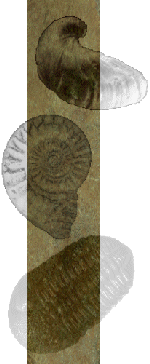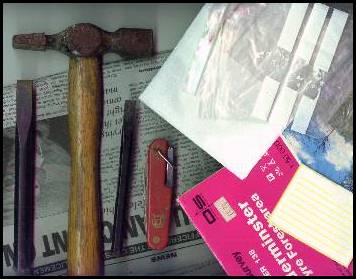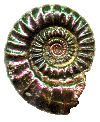






|

The equipment I use for extracting fossils is very basic and more "dedicated" collectors would probably laugh at the simplicity. Personally I have always liked 'Occams Razor' - the simplest solutions are usually the best. The equipment I use is shown in the picture:
- Hammer: An inexpensive lump of steel on the end of a stick. I have never felt the need to go to the expence of a geological hammer when my little £1.99 job can bang in tent pegs just as well.
- Chisels: I only carry two, 1cm and 1.5 cm. Cheap from any hardware store.
- Fake Swiss Army knife (made in China): For soft rock where a bang from a hammer would be disasterous. All the blades and widgets are ideal for the removal of a more delicate fossil. The corkscrew is invaluable during a relaxing break from all the hard work.
- A Map of the area: This is possibly the most important item you should have. It is impossible to plan a trip without a detailed map and it will prevent you from getting lost (most of the time). I find the Ordnance Survey Landranger series quite adequate for the purpose.(U.S.A. readers will have to work it out for themselvs)
- Resealable plastic bags to take stuff home in. Usually recycled from the ones I get with electronic components.
- Tissue paper for packing small and delicate items: Usually toilet roll from the camp site we are staying in at the time.
- Newspaper for wraping larger items: Usually a free "What's on in this area" paper that you can pick up in any bar or restaurant. Reverse logic on this one: - The paper is there to protect the other stuff in my backpack, my camera gear mostly, from being dented by the fossil!
- Sticky labels to record the date and place of the find. If you go totally OTT you can record the grid reference as well but I usually stick to the nearest town or village. I use excess floppy disk labels. Every time you buy a pack of disks you end up with too many labels and eventually end up with a drawerfull.
Once you have your bits of rock packed, carried home, unpacked, the real work starts......
Three things must be done:
Clean it: Remove excess rock and make it as pretty as possible.
This is a selection of the tools I use for cleaning my finds.
 A couple of dentists tools I found in a box of old junk on a market stall.
A couple of dentists tools I found in a box of old junk on a market stall.
A set of jewelers screwdrivers are excellent little chisels.
A magnifying glass is essential for work on small items.
A soft brush for clearing chippings and dust.
A toothbrush for scrubbing soft rock from harder fossils.
Some softer fossils and ones preserved in pyrites may require a little protection so I recomend a coat of lacquer. I have found that "Sally Hansen Hard As Nails" is good for the job.
Identify it: There is no point in having a wonderful specimen if you dont know what it is.
The series of three books produced by the British Museum (Natural History) -
British Palaeozoic Fossils
British Mesozoic Fossils
British Caenozoic Fossils
are indispensible works for the identification of specimens.
(Appologies once again to overseas readers you'll have to search the literature for yourself.)
Catalog it: Whether in a notebook or a computer database, record the 'where', 'when','what' and as much other information as possible. Believe me, after many years, you will forget where some of your specimens came from. I use the "cardfile" in Windows 3.11 but keep a paper copy too, just in case. I learned the hard way after a computer crash lost all my data.
Pictures on the Pages
All the images of the fossils on these pages were produced and directed by (fanfare) Me. The majority of the images were simply made by placing the fossil on a flatbed scanner then playing around with the image using Paintshop Pro. This is OK for fairly flat specimens. Larger items and close-up images were photographed with a 35mm camera and various attachments: extension tubes, telephoto lenses and the like.
The web pages were produced using HTML Writer and the imagemaps were produced using Mapedit.
Being a skinflint, versions of
 Paintshop Pro Paintshop Pro
 HTMLWriter HTMLWriter
 Mapedit Mapedit
 are available to download off the net. are available to download off the net.
|


















